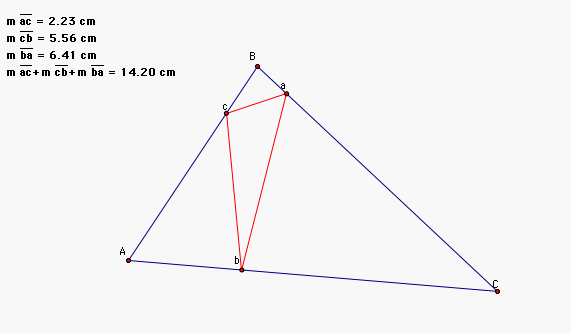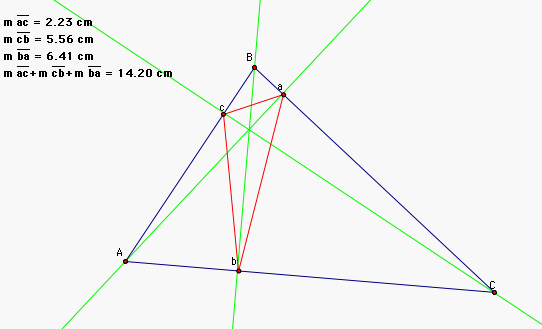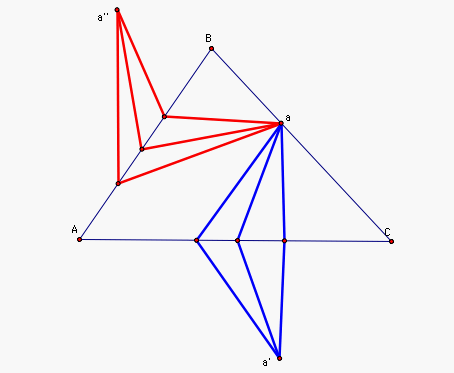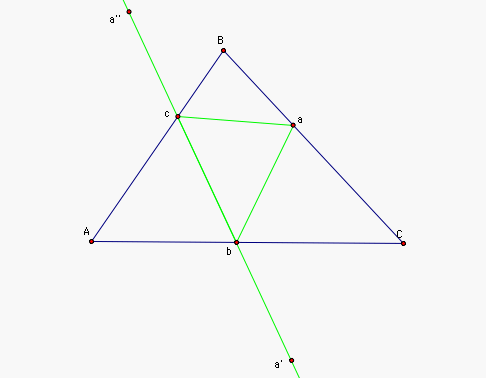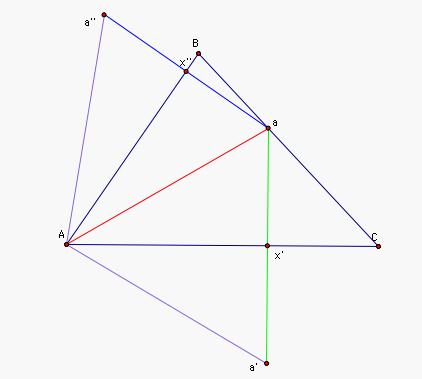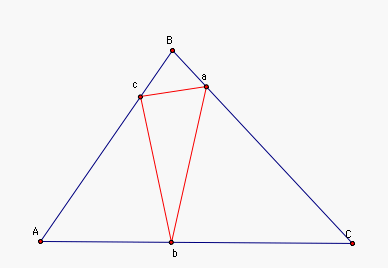Sarah Hofmann
EMAT 6680
Summer 2006
Assignment 8
|
I enjoyed the solution path
that I took in completing task number 15, so that is the task I have
chosen to write up. This was a fun problem to solve.
|
Problem 15: Find the
triangle of minimum perimeter that can be inscribed inside of a given
triangle.
|
To begin this problem, I drew an
acute triangle ABC and put points a,b, and c on the sides. I then
created the triangle abc. Next I measured the lengths of segments
ab, bc, and ca. Then I calculated their sum to find the
perimeter. Finally I used the animation function and some
movements by hand to find the approximate places where a, b, and c
should be located to minimize the perimeter. Then I repeated the
process to make sure that I indeed had the minimum perimeter. The
following is a picture of my final results.
|
Now I needed to look at my
results and come up with a hypothesis. It looks like if you
connected B and b with a segment it would almost create a right angle
with segment AC. Let's test this hypothesis by constructing those
perpendicular lines, shown in green below.
A you can see, the approximated points a, b, and c all look very close
to the intersections of the perpendicular lines and the segments.
So we now have a conjecture that the triangle of minimum perimeter that
can be constructed in a given triangle is the orthic triangle.
|
We begin by drawing triangle ABC and selecting a random point a on segment BC.
|
Next we will look at the
reflections of point a about
segment AC and AB. Call these points a' and a'' respectively.
|
Since a' is the reflection of a about AC, any point b on AC is equidistant from a and a'. Similarly, any point c on segment AB is equidistant from a and a'', as seen in the picture below.
|
So any triangle abc with fixed vertex a has perimeter
perim( abc) = m( ab) + m( bc) + m(ca) = m( a'b) + m( bc) + m( ca'').
In order to minimize the perimeter
of a hypothetical triangle abc
which has one of its verticies fixed at a, we must minimize m( a'b) and m( a''c) at the same time, so the
points b and c must lie on the line a'a''. So for any fixed point a on segment BC, the triangle of minimum
perimeter is shown below.
A similar statement is true for a random " b" point or a random "c" point. So the triangle we
are looking for must have this form in all three of its points.
|
Now let us look at the picture
below. Since a' is the
reflection of a about AC we know that m(ax') = m(x'a) and m(Aa) = m(Aa') as segments. Thus angle aAx' equals angle a'Ax'. Similarly angle aAx'' equalse angle a''Ax''. Thus the m(a''Aa') = m(a''Ax'') + m(x''Aa) + m(aAx') + m(x'Aa') = 2m(x''Aa) + 2m(aAx') = 2m(BAC).
Thus the position of a on BC does not affect the measure of
angle a'Aa''. The same
statement can be made for points b
and c. Thus all triangles that
fit our hypothesis have the same angles. Thus all triangles that
fit our hypothesis are similar.
|
The similar triangle with the
shortest length a'a'' has the
shortest m(Aa') = m(Aa). Thus the solution is true
when Aa is as short as
possible, which is when Aa is
perpendicular to BC.
Similarly Bb must be
perpendicular to AC and Cc must be perpendicular to AB. Therefore, abc must be the orthic triangle as
needed.
|
|
|
|
|
